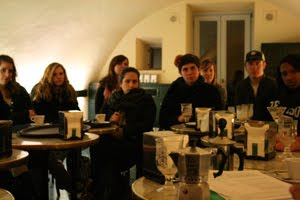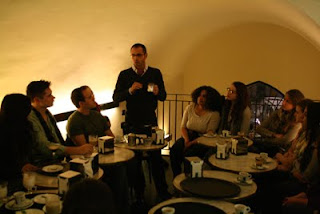Professor William Pettit III was asked to participate in a special on the art of fresco and the Sistine Chapel.
According to its website, in every episode of the History Channel’s program “Museum Secrets,” its troupe “travels to one extraordinary museum: the Louvre, the Vatican Museums, London’s Natural History Museum, the Royal Ontario Museum in Toronto [and] reveals the stories of one of its irreplaceable treasures: the Mona Lisa, the Sistine Chapel, the golden mask of King Tut, and many more. Museum Secrets probes familiar legends and assumptions, using cutting edge research and technology to investigate the unknown.”
It’s no surprise that Umbra’s dashing and affable fine arts professor would be a candidate for a  television special, but it was his expertise in the technique known as buon fresco that got him involved in this particular project. Buon fresco is a process, perfected in the fifteenth century in Italy, of painting on a wet lime-mortar covered wall. Michelangelo, Leonardo, and Raffaelo all used it—and William Pettit teaches it. Pettit was asked to participate in the episode on the Vatican Museums, which discusses Michelangelo’s frescoes in the Sistine Chapel.
television special, but it was his expertise in the technique known as buon fresco that got him involved in this particular project. Buon fresco is a process, perfected in the fifteenth century in Italy, of painting on a wet lime-mortar covered wall. Michelangelo, Leonardo, and Raffaelo all used it—and William Pettit teaches it. Pettit was asked to participate in the episode on the Vatican Museums, which discusses Michelangelo’s frescoes in the Sistine Chapel.
The Umbra professor was contacted by the producers because he is one of the few artists and instructors of the fresco painting technique working today. In particular, they were interested in a demonstration of the techniques of cartoon transfer—pouncing and incising—which he also teaches to his students at the Umbra Institute in his ARFP 210: Fresco Painting course. The demonstration involved producing a full sized drawing (cartoon) of Michelangelo’s Adam, and transferring the drawing onto a fresco wall Pettit had prepared. The series was aired on the History Channel on January 6.
The Umbra Institute is now in its third year of offering the class as part of its fine arts program. Want to know more? Click here for a description of Professor Pettit’s class.
 It’s that time of the semester, once again, when students wash their feet and stomp on buckets of grapes. It may not be the most desirable thought to consume wine made by your own feet, but the process has been used for generations in Italy. Staff member Zach Nowak led the group in the process of making wine and each student who participated in the wine making course will have a bottle of wine to take back to the United States.
It’s that time of the semester, once again, when students wash their feet and stomp on buckets of grapes. It may not be the most desirable thought to consume wine made by your own feet, but the process has been used for generations in Italy. Staff member Zach Nowak led the group in the process of making wine and each student who participated in the wine making course will have a bottle of wine to take back to the United States.

 Using a bit of wit, a dash of humor, and their mastery of the Italian language, the Italian 310 students solved their very own game of Clue. Barbara, Umbra Institute’s Italian 310 professoressa, cleverly created roles, scripts, and a ‘theft’ to be acted out over a birthday dinner for two of her students.
Using a bit of wit, a dash of humor, and their mastery of the Italian language, the Italian 310 students solved their very own game of Clue. Barbara, Umbra Institute’s Italian 310 professoressa, cleverly created roles, scripts, and a ‘theft’ to be acted out over a birthday dinner for two of her students. Well, not quite, but it sure feels like it! With about a week of nearly 60 degree weather behind us and more to come, spring is in the air at the Umbra Institute! The students are beginning to get a taste of what the outdoors life is like in Italy: the main point of congregation is
Well, not quite, but it sure feels like it! With about a week of nearly 60 degree weather behind us and more to come, spring is in the air at the Umbra Institute! The students are beginning to get a taste of what the outdoors life is like in Italy: the main point of congregation is  Last Thursday, during a wine tasting in a local Perugian enoteca, Umbra students transformed into knowledgeable wine connoisseurs. The art of vino came alive thanks to the expert, Sylvia, and the helpful enoteca owner and staff. They explained everything from reading labels, to pairing foods with a wine’s acidity, to using the senses to examine and, of course, enjoy a quality bottle of wine.
Last Thursday, during a wine tasting in a local Perugian enoteca, Umbra students transformed into knowledgeable wine connoisseurs. The art of vino came alive thanks to the expert, Sylvia, and the helpful enoteca owner and staff. They explained everything from reading labels, to pairing foods with a wine’s acidity, to using the senses to examine and, of course, enjoy a quality bottle of wine. Umbra Institute students last night enjoyed more than a hot cup of Joe. Umbra staff member Mauro Renna and history prof Zachary Nowak entertained students who participated in the Coffee Workshop, offered as part of Umbra’s extra-curricular series of food workshops. Renna and Nowak described the convoluted and often odd history of that bean which lets us start our mornings, from its domestication in Ethiopia and export from the Yemenese port of (get this!) Al-Moka, through its arrival in Venice and quick spread through Europe.
Umbra Institute students last night enjoyed more than a hot cup of Joe. Umbra staff member Mauro Renna and history prof Zachary Nowak entertained students who participated in the Coffee Workshop, offered as part of Umbra’s extra-curricular series of food workshops. Renna and Nowak described the convoluted and often odd history of that bean which lets us start our mornings, from its domestication in Ethiopia and export from the Yemenese port of (get this!) Al-Moka, through its arrival in Venice and quick spread through Europe.

 Perugia has about a 3 to 1 ratio of nooks to crannies, Umbra Institute students found out yesterday. Sunday afternoon saw two editions of the “almost internationally-renowned” (as history professor Zachary Nowak describes it) tour of Perugia. Nowak took the students on a sun-drenched traipse around Perugia’s center, recounting anecdotes and stories about monuments and people in Perugia’s past.
Perugia has about a 3 to 1 ratio of nooks to crannies, Umbra Institute students found out yesterday. Sunday afternoon saw two editions of the “almost internationally-renowned” (as history professor Zachary Nowak describes it) tour of Perugia. Nowak took the students on a sun-drenched traipse around Perugia’s center, recounting anecdotes and stories about monuments and people in Perugia’s past. television special, but it was his expertise in the technique known as buon fresco that got him involved in this particular project. Buon fresco is a process, perfected in the fifteenth century in Italy, of painting on a wet lime-mortar covered wall. Michelangelo, Leonardo, and Raffaelo all used it—and William Pettit teaches it. Pettit was asked to participate in the episode on the Vatican Museums, which discusses Michelangelo’s frescoes in the Sistine Chapel.
television special, but it was his expertise in the technique known as buon fresco that got him involved in this particular project. Buon fresco is a process, perfected in the fifteenth century in Italy, of painting on a wet lime-mortar covered wall. Michelangelo, Leonardo, and Raffaelo all used it—and William Pettit teaches it. Pettit was asked to participate in the episode on the Vatican Museums, which discusses Michelangelo’s frescoes in the Sistine Chapel. over-hundred strong student body members got to Rome’s Fiumicino airport on Friday, yesterday was the real beginning of their Umbra experience. The day began with housing: students were taken in taxis from the hotel where they had stayed and had their Welcome Dinner to their apartments up in Perugia’s beautiful historic center. Some apartments have frescoes, some have majestic views (often four flights up, but worth the sweat!), but all are our “temporary citizens” homes for the next four months.
over-hundred strong student body members got to Rome’s Fiumicino airport on Friday, yesterday was the real beginning of their Umbra experience. The day began with housing: students were taken in taxis from the hotel where they had stayed and had their Welcome Dinner to their apartments up in Perugia’s beautiful historic center. Some apartments have frescoes, some have majestic views (often four flights up, but worth the sweat!), but all are our “temporary citizens” homes for the next four months. main piazza. There was a greeting from Resident Director Anna Girolimetti and an introduction from Professor Elgin Eckert. The third speaker was Officer Michele Canneschi, who talked to the students on behalf of the Italian police forces about safety and security in Italy. Today, students will get additional information in their break-out orientation meetings with staff members, then ask questions during the Open House.
main piazza. There was a greeting from Resident Director Anna Girolimetti and an introduction from Professor Elgin Eckert. The third speaker was Officer Michele Canneschi, who talked to the students on behalf of the Italian police forces about safety and security in Italy. Today, students will get additional information in their break-out orientation meetings with staff members, then ask questions during the Open House.